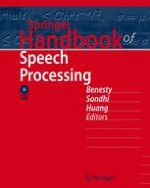2008 | OriginalPaper | Buchkapitel
9. Homomorphic Systems and Cepstrum Analysis of Speech
verfasst von : Ronald W. Schafer, Prof.
Erschienen in: Springer Handbook of Speech Processing
Verlag: Springer Berlin Heidelberg
Aktivieren Sie unsere intelligente Suche, um passende Fachinhalte oder Patente zu finden.
Wählen Sie Textabschnitte aus um mit Künstlicher Intelligenz passenden Patente zu finden. powered by
Markieren Sie Textabschnitte, um KI-gestützt weitere passende Inhalte zu finden. powered by
Abstract
As an aid in formalizing this new point of view, they introduced a number of paraphrased words. For example, they defined the cepstrum of a signal as the power spectrum of the logarithm of the power spectrum of a signal. (In fact, they used discrete-time spectrum estimates based on the discrete Fourier transform.) Similarly, the term quefrency was introduced for the independent variable of the cepstrum [9.1].In general, we find ourselves operating on the frequency side in ways customary on the time side and vice versa.
